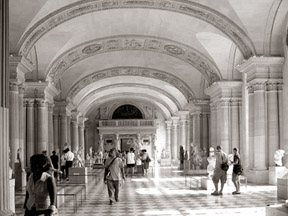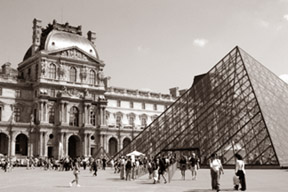|
observer |
|
|
|
|
|
OTHER LINKS |

|

|

|
The Louvre:Museum extraordinaire
As the strength of the French monarchy grew in the Middle Ages, a need arose to protect the capital of Paris from the Anglo-Norman threat. A rampart was built around Paris and shortly afterward, around 1190, a fortress was constructed under the direction of Philippe Auguste. The fortress came to be called the Louvre. The Louvre fortress was built for the purpose of defense and consisted of a rectangular structure surrounded by a moat and accompanied by several round bastions. At the centre of the structure stood a huge keep, known as the Grosse Tour. By the 14th century, Paris had expanded considerably and newer defenses were raised to protect its new boundaries. Since the Louvre was no longer a necessary part of the city's defense, Charles V began transforming the fortress into a grand royal residence. Living apartments were added to the original structure, gardens were created and a grand staircase was built to reach the upper floors of the new structures which were decorated with sculptures, tapestries and paintings. The tide of renovation that began with Charles V in the mid-14th century continued until the reign of Louis XIV, who made the newly completed Palace of Versailles his home, around 1672. During this period, much of the medieval structure was demolished and several new galleries, halls and pavilions were constructed in the Renaissance style. One significant change instituted by Henri IV in his Grand Design was the construction of the Grande Galerie, a passage between the Louvre and The Tuileries Palace, a short distance away.
Further construction continued under Louis XV. In the late 18th century, the Louvre was dedicated by the revolutionary National Assembly to house the king as well as monuments of the sciences and the arts. In 1793, the Louvre opened for the first time to the public as a museum in the Grande Galerie and the Salon Carre under the direction of the Minister of the Interior. The works on display were the collections of the royal family and those of other French aristocrats. With the conquest of Napoleon I, the newly created Musee Louvre was enriched with numerous works of art from all over the world at a phenomenal rate. Significant acquisitions included Egyptian, Assyrian, Mexican and Spanish art. Additional contributions were added during the Second Empire in the mid-19th century which included an impressive selection of Greek pottery and Etruscan antiquities. During the last days of the Paris Commune, the Tuileries Palace was destroyed, ending the connection of the Louvre with a seat of power. Bit by bit, the Louvre was used as a place to display important cultural artifacts and works of art. In 1926, the French director of museums initiated a plan for increasing exhibition space in the Louvre. This plan was executed over a number of decades and through World Wars I and II, during which time most of the artworks were moved out of the Louvre for safekeeping. In 1945, at the end of World War II, a plan for reorganizing French works of art was instituted. A significant change included the annexation of the Jeu de Paume, which contained impressionist works, to the Louvre to become the Museum of Impressionism. Since this time, however, these works of art have since been moved to the Musee d'Orsay. One of the most recent additions to the Louvre is the glass Pyramid, inaugurated in 1989. The Pyramid now serves as the museum's main entrance to the galleries as well as an auditorium, bookshop, cafeteria and restaurant. Expansions and renovations continue to take place and recent acquisitions include Near Eastern antiquities as well as tribal and aboriginal art. Today, the Louvre is without doubt, one of the best known museums in the world, and houses close to 35,000 works of art. The museum received over 7 million visitors in 2005 and only about one third of these visitors were French. (Courtesy:www.bellaonline.com) |
 The Louvre, world famous museum extraordinaire located in Paris,
France, has evolved through a number of demolitions, renovations and
expansions to bring it to the state in which we see it today. In fact,
the Louvre was not always a museum, but was originally built as a
fortress in the late 1100s to protect the increasingly influential city
of Paris from the threat of invaders.
The Louvre, world famous museum extraordinaire located in Paris,
France, has evolved through a number of demolitions, renovations and
expansions to bring it to the state in which we see it today. In fact,
the Louvre was not always a museum, but was originally built as a
fortress in the late 1100s to protect the increasingly influential city
of Paris from the threat of invaders.  Although Louis XIV moved the royal residence to Versailles in 1672,
he created an antique sculpture gallery in the Louvre in 1692 and
invited several academic groups to take up residence there. In 1699, the
Royal Academy of Painting and Sculpture held the first of many exhibits
that were open to the public and afterward known as "The Salon."
Although Louis XIV moved the royal residence to Versailles in 1672,
he created an antique sculpture gallery in the Louvre in 1692 and
invited several academic groups to take up residence there. In 1699, the
Royal Academy of Painting and Sculpture held the first of many exhibits
that were open to the public and afterward known as "The Salon." 







